Macroeconomics Homework: Analysis of Economic Shocks and Policies
VerifiedAdded on 2020/03/04
|17
|2686
|46
Homework Assignment
AI Summary
This macroeconomics assignment delves into key economic concepts through multiple-choice questions and in-depth analysis. It examines the Solow Growth Model, purchasing power parity, and the impact of investment on the IS curve, analyzing the effects of tax breaks on capital stock and the resulting shifts in the full employment curve and LM curve. The assignment also explores the current state of the international economy, discussing global growth, inflation trends, and the role of central banks in maintaining stability. Furthermore, it investigates the effects of a burst in inflation, including the role of IS and LM curves, and the potential responses from the Federal Reserve, including fiscal and monetary policies to control inflation and stabilize the economy. Finally, the assignment analyzes shocks to trade, examining the effects of increased productivity and comparative advantage on the FE, IS, and LM curves, and their impact on price levels and inflation.
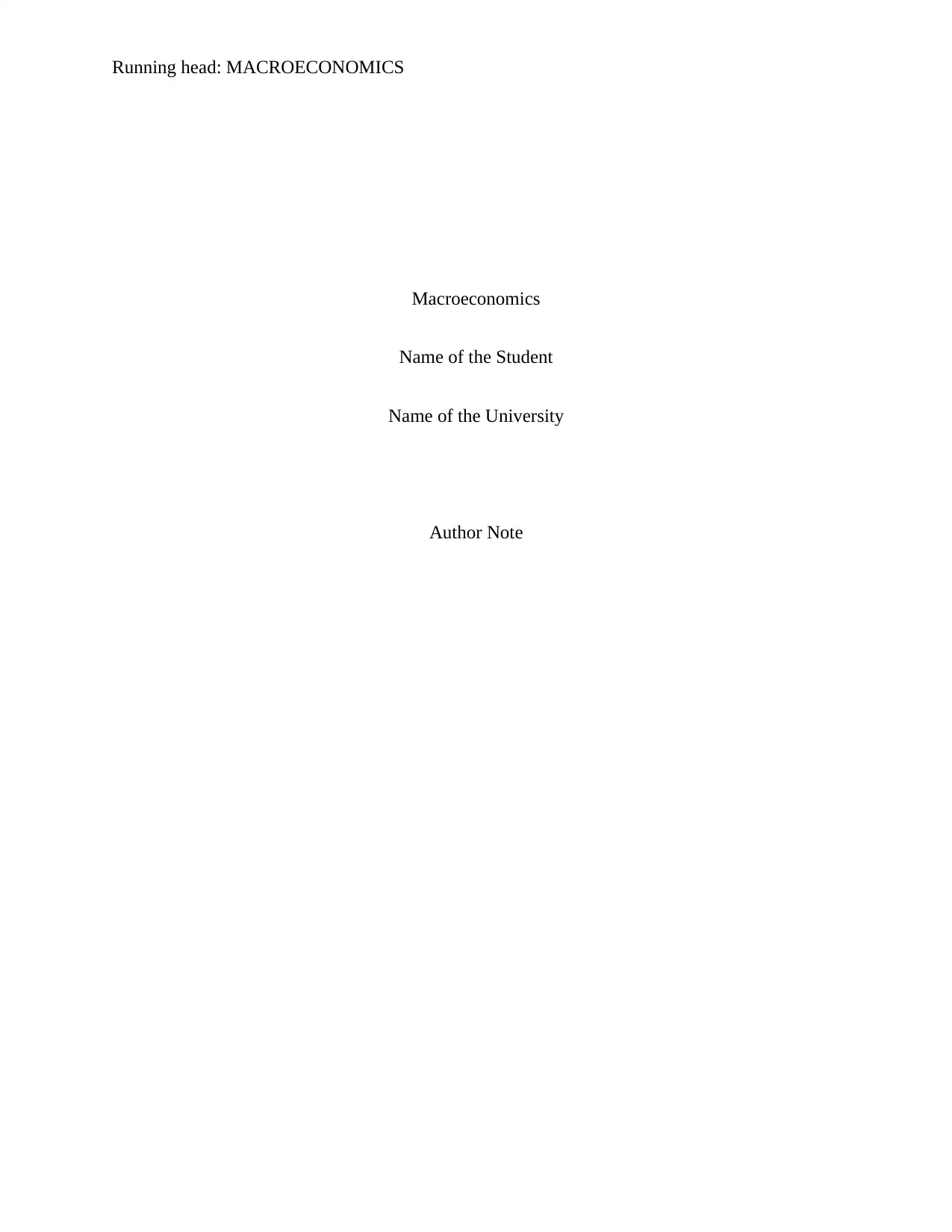
Running head: MACROECONOMICS
Macroeconomics
Name of the Student
Name of the University
Author Note
Macroeconomics
Name of the Student
Name of the University
Author Note
Paraphrase This Document
Need a fresh take? Get an instant paraphrase of this document with our AI Paraphraser
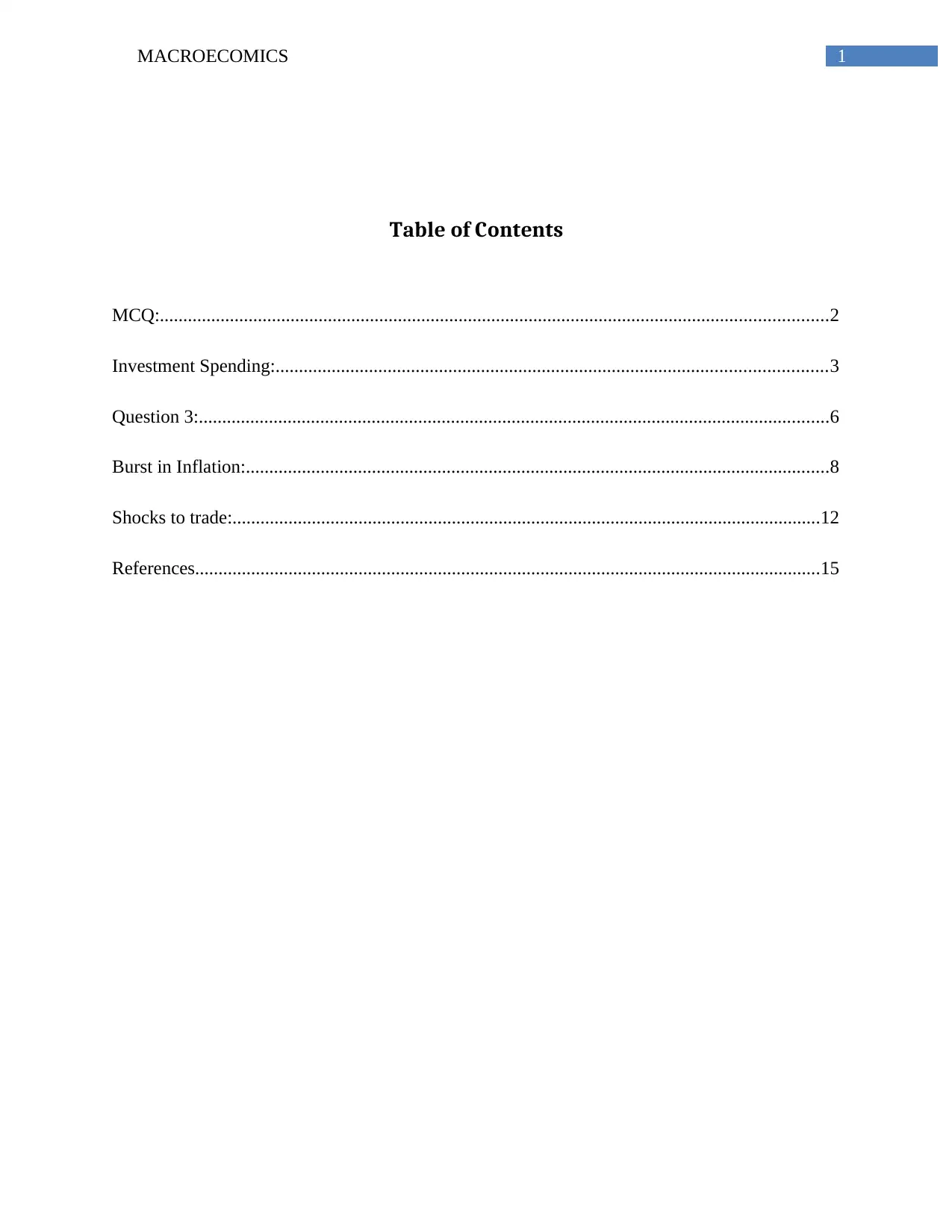
1MACROECOMICS
Table of Contents
MCQ:...............................................................................................................................................2
Investment Spending:......................................................................................................................3
Question 3:.......................................................................................................................................6
Burst in Inflation:.............................................................................................................................8
Shocks to trade:..............................................................................................................................12
References......................................................................................................................................15
Table of Contents
MCQ:...............................................................................................................................................2
Investment Spending:......................................................................................................................3
Question 3:.......................................................................................................................................6
Burst in Inflation:.............................................................................................................................8
Shocks to trade:..............................................................................................................................12
References......................................................................................................................................15
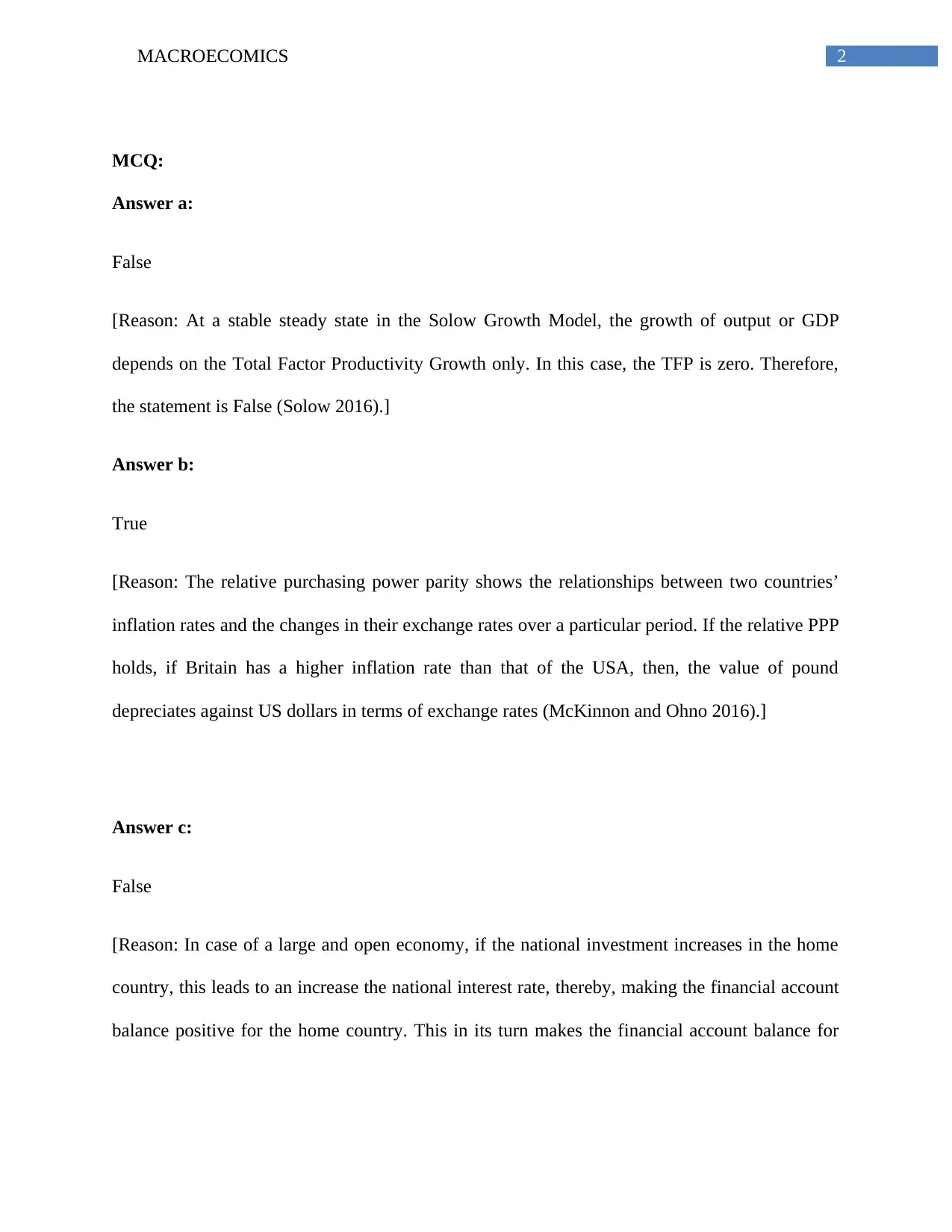
2MACROECOMICS
MCQ:
Answer a:
False
[Reason: At a stable steady state in the Solow Growth Model, the growth of output or GDP
depends on the Total Factor Productivity Growth only. In this case, the TFP is zero. Therefore,
the statement is False (Solow 2016).]
Answer b:
True
[Reason: The relative purchasing power parity shows the relationships between two countries’
inflation rates and the changes in their exchange rates over a particular period. If the relative PPP
holds, if Britain has a higher inflation rate than that of the USA, then, the value of pound
depreciates against US dollars in terms of exchange rates (McKinnon and Ohno 2016).]
Answer c:
False
[Reason: In case of a large and open economy, if the national investment increases in the home
country, this leads to an increase the national interest rate, thereby, making the financial account
balance positive for the home country. This in its turn makes the financial account balance for
MCQ:
Answer a:
False
[Reason: At a stable steady state in the Solow Growth Model, the growth of output or GDP
depends on the Total Factor Productivity Growth only. In this case, the TFP is zero. Therefore,
the statement is False (Solow 2016).]
Answer b:
True
[Reason: The relative purchasing power parity shows the relationships between two countries’
inflation rates and the changes in their exchange rates over a particular period. If the relative PPP
holds, if Britain has a higher inflation rate than that of the USA, then, the value of pound
depreciates against US dollars in terms of exchange rates (McKinnon and Ohno 2016).]
Answer c:
False
[Reason: In case of a large and open economy, if the national investment increases in the home
country, this leads to an increase the national interest rate, thereby, making the financial account
balance positive for the home country. This in its turn makes the financial account balance for
⊘ This is a preview!⊘
Do you want full access?
Subscribe today to unlock all pages.

Trusted by 1+ million students worldwide
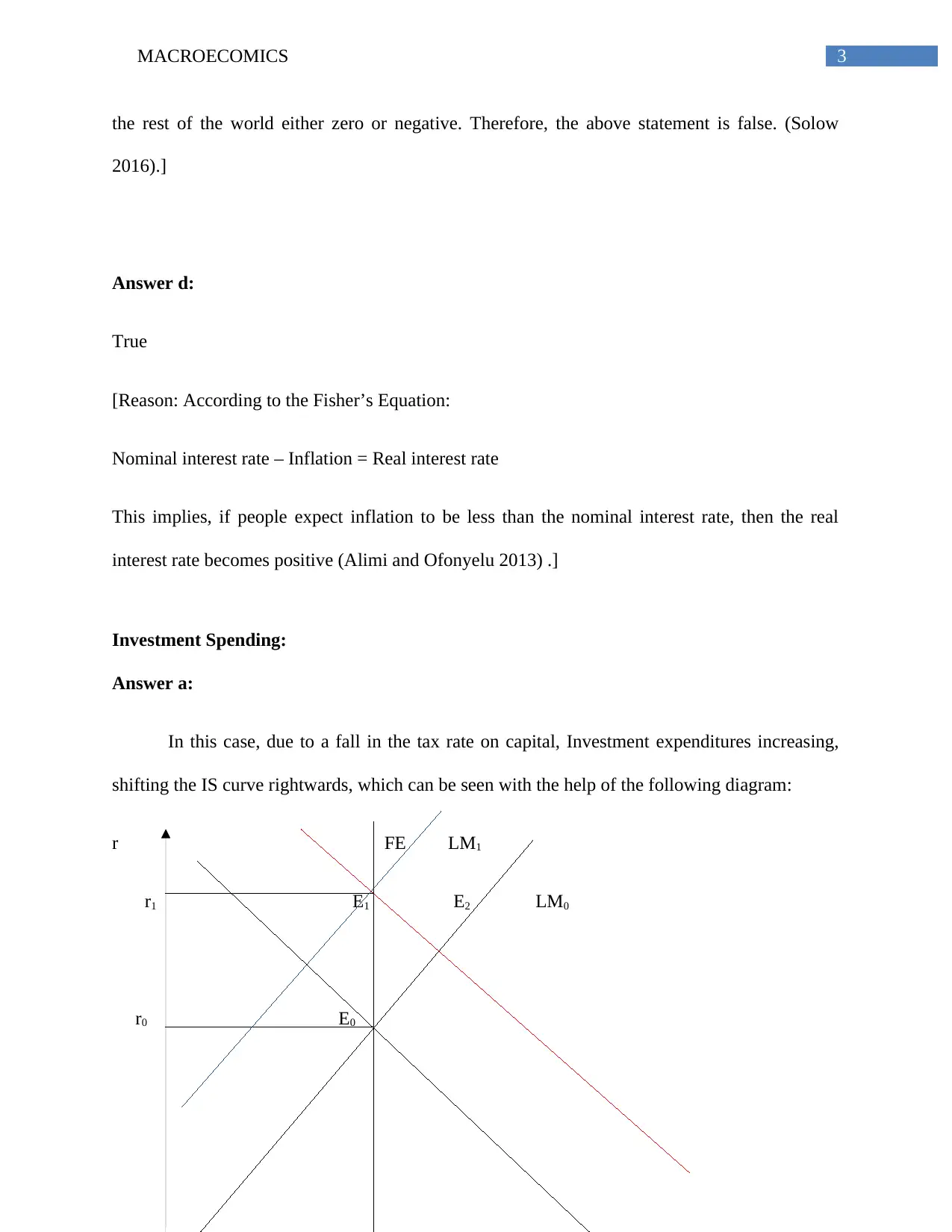
3MACROECOMICS
the rest of the world either zero or negative. Therefore, the above statement is false. (Solow
2016).]
Answer d:
True
[Reason: According to the Fisher’s Equation:
Nominal interest rate – Inflation = Real interest rate
This implies, if people expect inflation to be less than the nominal interest rate, then the real
interest rate becomes positive (Alimi and Ofonyelu 2013) .]
Investment Spending:
Answer a:
In this case, due to a fall in the tax rate on capital, Investment expenditures increasing,
shifting the IS curve rightwards, which can be seen with the help of the following diagram:
r FE LM1
r1 E1 E2 LM0
r0 E0
the rest of the world either zero or negative. Therefore, the above statement is false. (Solow
2016).]
Answer d:
True
[Reason: According to the Fisher’s Equation:
Nominal interest rate – Inflation = Real interest rate
This implies, if people expect inflation to be less than the nominal interest rate, then the real
interest rate becomes positive (Alimi and Ofonyelu 2013) .]
Investment Spending:
Answer a:
In this case, due to a fall in the tax rate on capital, Investment expenditures increasing,
shifting the IS curve rightwards, which can be seen with the help of the following diagram:
r FE LM1
r1 E1 E2 LM0
r0 E0
Paraphrase This Document
Need a fresh take? Get an instant paraphrase of this document with our AI Paraphraser
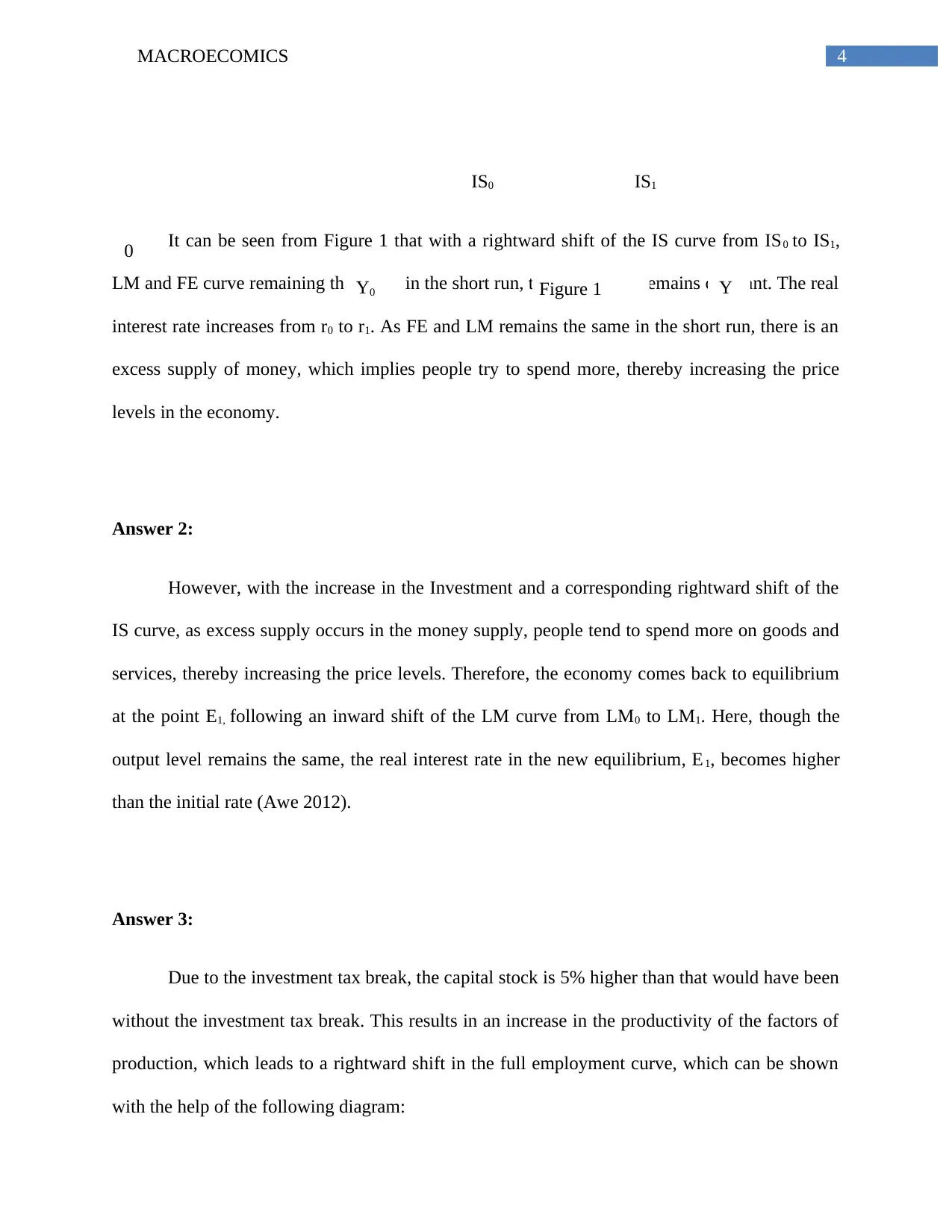
4MACROECOMICS
IS0 IS1
It can be seen from Figure 1 that with a rightward shift of the IS curve from IS0 to IS1,
LM and FE curve remaining the same, in the short run, the real output remains constant. The real
interest rate increases from r0 to r1. As FE and LM remains the same in the short run, there is an
excess supply of money, which implies people try to spend more, thereby increasing the price
levels in the economy.
Answer 2:
However, with the increase in the Investment and a corresponding rightward shift of the
IS curve, as excess supply occurs in the money supply, people tend to spend more on goods and
services, thereby increasing the price levels. Therefore, the economy comes back to equilibrium
at the point E1, following an inward shift of the LM curve from LM0 to LM1. Here, though the
output level remains the same, the real interest rate in the new equilibrium, E1, becomes higher
than the initial rate (Awe 2012).
Answer 3:
Due to the investment tax break, the capital stock is 5% higher than that would have been
without the investment tax break. This results in an increase in the productivity of the factors of
production, which leads to a rightward shift in the full employment curve, which can be shown
with the help of the following diagram:
0
YY0 Figure 1
IS0 IS1
It can be seen from Figure 1 that with a rightward shift of the IS curve from IS0 to IS1,
LM and FE curve remaining the same, in the short run, the real output remains constant. The real
interest rate increases from r0 to r1. As FE and LM remains the same in the short run, there is an
excess supply of money, which implies people try to spend more, thereby increasing the price
levels in the economy.
Answer 2:
However, with the increase in the Investment and a corresponding rightward shift of the
IS curve, as excess supply occurs in the money supply, people tend to spend more on goods and
services, thereby increasing the price levels. Therefore, the economy comes back to equilibrium
at the point E1, following an inward shift of the LM curve from LM0 to LM1. Here, though the
output level remains the same, the real interest rate in the new equilibrium, E1, becomes higher
than the initial rate (Awe 2012).
Answer 3:
Due to the investment tax break, the capital stock is 5% higher than that would have been
without the investment tax break. This results in an increase in the productivity of the factors of
production, which leads to a rightward shift in the full employment curve, which can be shown
with the help of the following diagram:
0
YY0 Figure 1
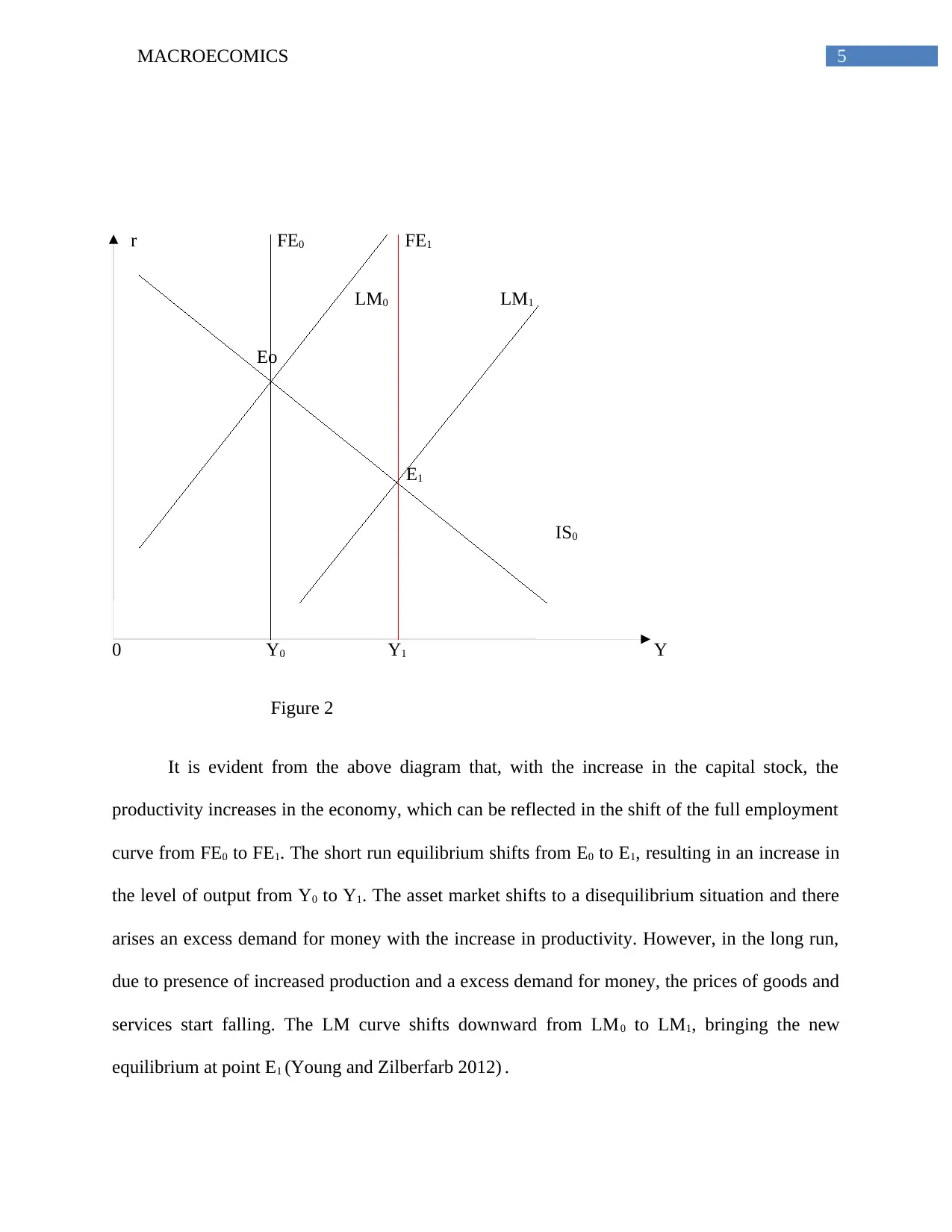
5MACROECOMICS
r FE0 FE1
LM0 LM1
Eo
E1
IS0
0 Y0 Y1 Y
Figure 2
It is evident from the above diagram that, with the increase in the capital stock, the
productivity increases in the economy, which can be reflected in the shift of the full employment
curve from FE0 to FE1. The short run equilibrium shifts from E0 to E1, resulting in an increase in
the level of output from Y0 to Y1. The asset market shifts to a disequilibrium situation and there
arises an excess demand for money with the increase in productivity. However, in the long run,
due to presence of increased production and a excess demand for money, the prices of goods and
services start falling. The LM curve shifts downward from LM0 to LM1, bringing the new
equilibrium at point E1 (Young and Zilberfarb 2012) .
r FE0 FE1
LM0 LM1
Eo
E1
IS0
0 Y0 Y1 Y
Figure 2
It is evident from the above diagram that, with the increase in the capital stock, the
productivity increases in the economy, which can be reflected in the shift of the full employment
curve from FE0 to FE1. The short run equilibrium shifts from E0 to E1, resulting in an increase in
the level of output from Y0 to Y1. The asset market shifts to a disequilibrium situation and there
arises an excess demand for money with the increase in productivity. However, in the long run,
due to presence of increased production and a excess demand for money, the prices of goods and
services start falling. The LM curve shifts downward from LM0 to LM1, bringing the new
equilibrium at point E1 (Young and Zilberfarb 2012) .
⊘ This is a preview!⊘
Do you want full access?
Subscribe today to unlock all pages.

Trusted by 1+ million students worldwide
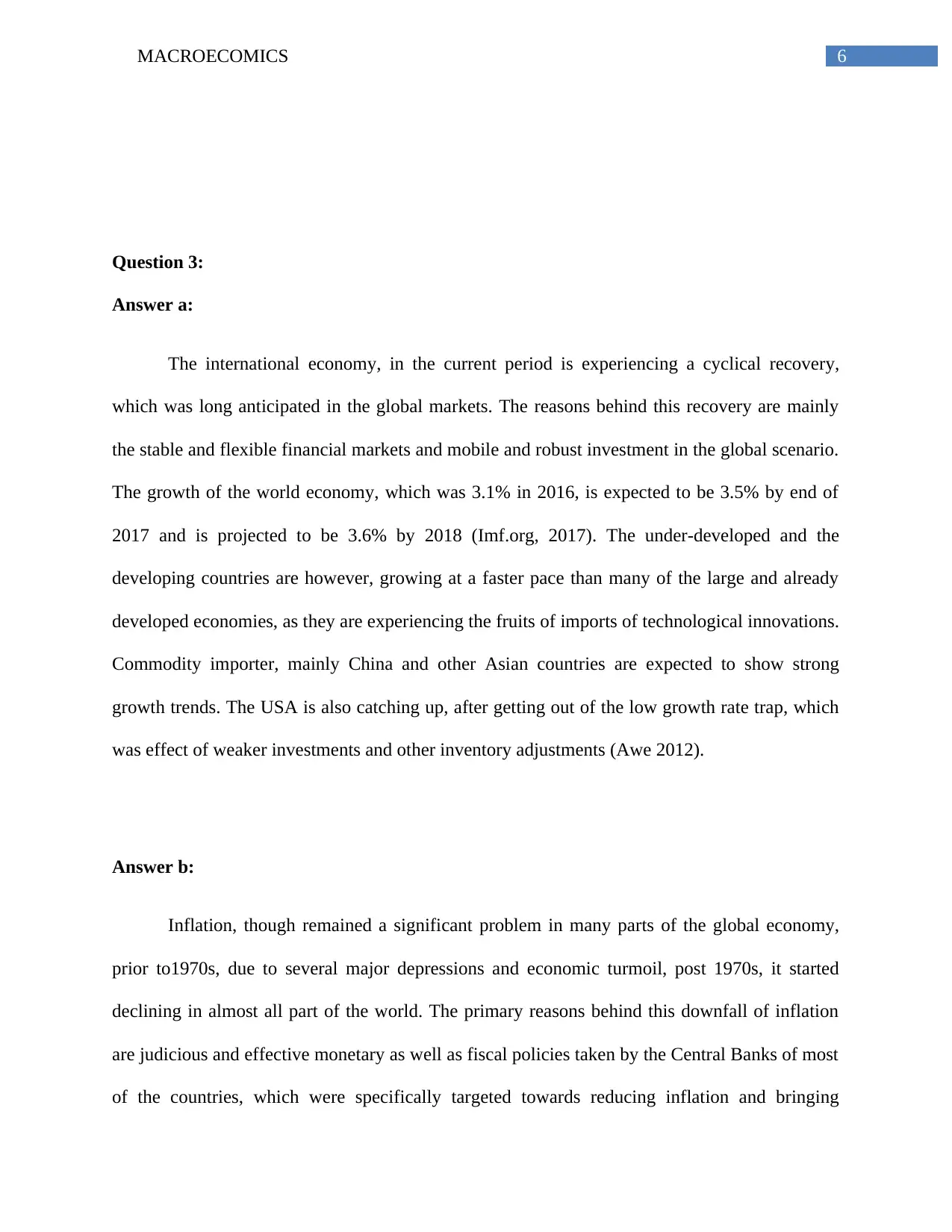
6MACROECOMICS
Question 3:
Answer a:
The international economy, in the current period is experiencing a cyclical recovery,
which was long anticipated in the global markets. The reasons behind this recovery are mainly
the stable and flexible financial markets and mobile and robust investment in the global scenario.
The growth of the world economy, which was 3.1% in 2016, is expected to be 3.5% by end of
2017 and is projected to be 3.6% by 2018 (Imf.org, 2017). The under-developed and the
developing countries are however, growing at a faster pace than many of the large and already
developed economies, as they are experiencing the fruits of imports of technological innovations.
Commodity importer, mainly China and other Asian countries are expected to show strong
growth trends. The USA is also catching up, after getting out of the low growth rate trap, which
was effect of weaker investments and other inventory adjustments (Awe 2012).
Answer b:
Inflation, though remained a significant problem in many parts of the global economy,
prior to1970s, due to several major depressions and economic turmoil, post 1970s, it started
declining in almost all part of the world. The primary reasons behind this downfall of inflation
are judicious and effective monetary as well as fiscal policies taken by the Central Banks of most
of the countries, which were specifically targeted towards reducing inflation and bringing
Question 3:
Answer a:
The international economy, in the current period is experiencing a cyclical recovery,
which was long anticipated in the global markets. The reasons behind this recovery are mainly
the stable and flexible financial markets and mobile and robust investment in the global scenario.
The growth of the world economy, which was 3.1% in 2016, is expected to be 3.5% by end of
2017 and is projected to be 3.6% by 2018 (Imf.org, 2017). The under-developed and the
developing countries are however, growing at a faster pace than many of the large and already
developed economies, as they are experiencing the fruits of imports of technological innovations.
Commodity importer, mainly China and other Asian countries are expected to show strong
growth trends. The USA is also catching up, after getting out of the low growth rate trap, which
was effect of weaker investments and other inventory adjustments (Awe 2012).
Answer b:
Inflation, though remained a significant problem in many parts of the global economy,
prior to1970s, due to several major depressions and economic turmoil, post 1970s, it started
declining in almost all part of the world. The primary reasons behind this downfall of inflation
are judicious and effective monetary as well as fiscal policies taken by the Central Banks of most
of the countries, which were specifically targeted towards reducing inflation and bringing
Paraphrase This Document
Need a fresh take? Get an instant paraphrase of this document with our AI Paraphraser
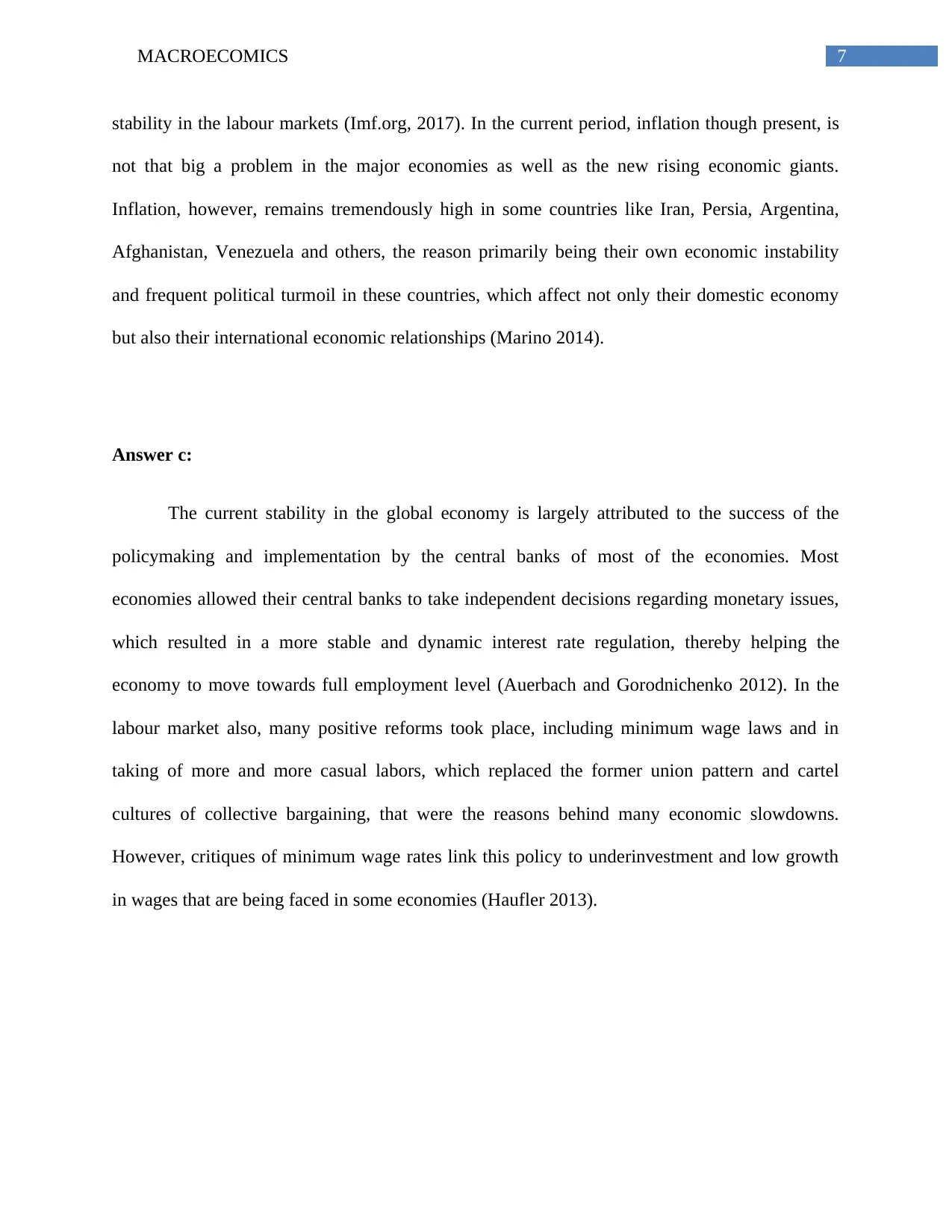
7MACROECOMICS
stability in the labour markets (Imf.org, 2017). In the current period, inflation though present, is
not that big a problem in the major economies as well as the new rising economic giants.
Inflation, however, remains tremendously high in some countries like Iran, Persia, Argentina,
Afghanistan, Venezuela and others, the reason primarily being their own economic instability
and frequent political turmoil in these countries, which affect not only their domestic economy
but also their international economic relationships (Marino 2014).
Answer c:
The current stability in the global economy is largely attributed to the success of the
policymaking and implementation by the central banks of most of the economies. Most
economies allowed their central banks to take independent decisions regarding monetary issues,
which resulted in a more stable and dynamic interest rate regulation, thereby helping the
economy to move towards full employment level (Auerbach and Gorodnichenko 2012). In the
labour market also, many positive reforms took place, including minimum wage laws and in
taking of more and more casual labors, which replaced the former union pattern and cartel
cultures of collective bargaining, that were the reasons behind many economic slowdowns.
However, critiques of minimum wage rates link this policy to underinvestment and low growth
in wages that are being faced in some economies (Haufler 2013).
stability in the labour markets (Imf.org, 2017). In the current period, inflation though present, is
not that big a problem in the major economies as well as the new rising economic giants.
Inflation, however, remains tremendously high in some countries like Iran, Persia, Argentina,
Afghanistan, Venezuela and others, the reason primarily being their own economic instability
and frequent political turmoil in these countries, which affect not only their domestic economy
but also their international economic relationships (Marino 2014).
Answer c:
The current stability in the global economy is largely attributed to the success of the
policymaking and implementation by the central banks of most of the economies. Most
economies allowed their central banks to take independent decisions regarding monetary issues,
which resulted in a more stable and dynamic interest rate regulation, thereby helping the
economy to move towards full employment level (Auerbach and Gorodnichenko 2012). In the
labour market also, many positive reforms took place, including minimum wage laws and in
taking of more and more casual labors, which replaced the former union pattern and cartel
cultures of collective bargaining, that were the reasons behind many economic slowdowns.
However, critiques of minimum wage rates link this policy to underinvestment and low growth
in wages that are being faced in some economies (Haufler 2013).
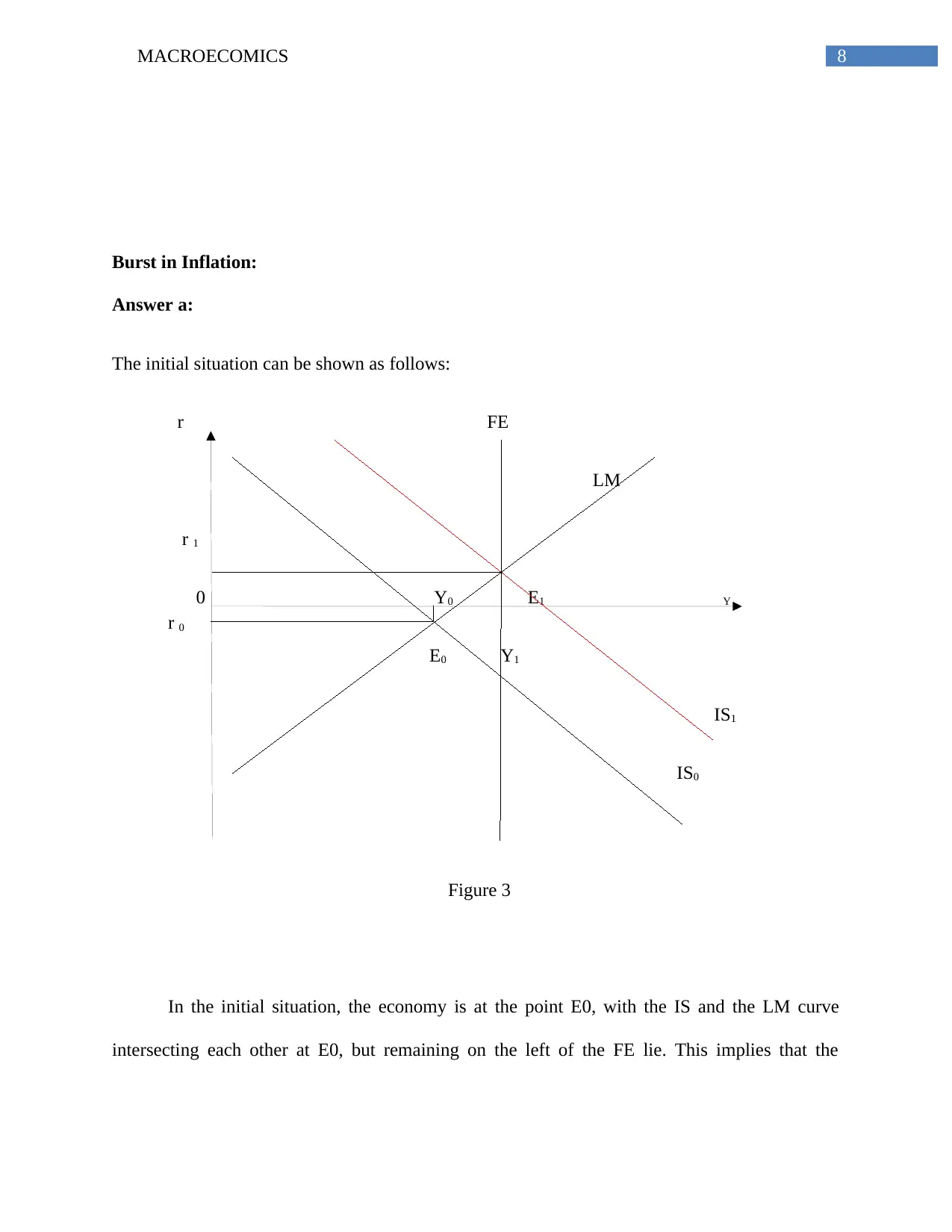
8MACROECOMICS
Burst in Inflation:
Answer a:
The initial situation can be shown as follows:
r FE
LM
r 1
0 Y0 E1 Y
E0 Y1
IS1
IS0
Figure 3
In the initial situation, the economy is at the point E0, with the IS and the LM curve
intersecting each other at E0, but remaining on the left of the FE lie. This implies that the
r 0
Burst in Inflation:
Answer a:
The initial situation can be shown as follows:
r FE
LM
r 1
0 Y0 E1 Y
E0 Y1
IS1
IS0
Figure 3
In the initial situation, the economy is at the point E0, with the IS and the LM curve
intersecting each other at E0, but remaining on the left of the FE lie. This implies that the
r 0
⊘ This is a preview!⊘
Do you want full access?
Subscribe today to unlock all pages.

Trusted by 1+ million students worldwide
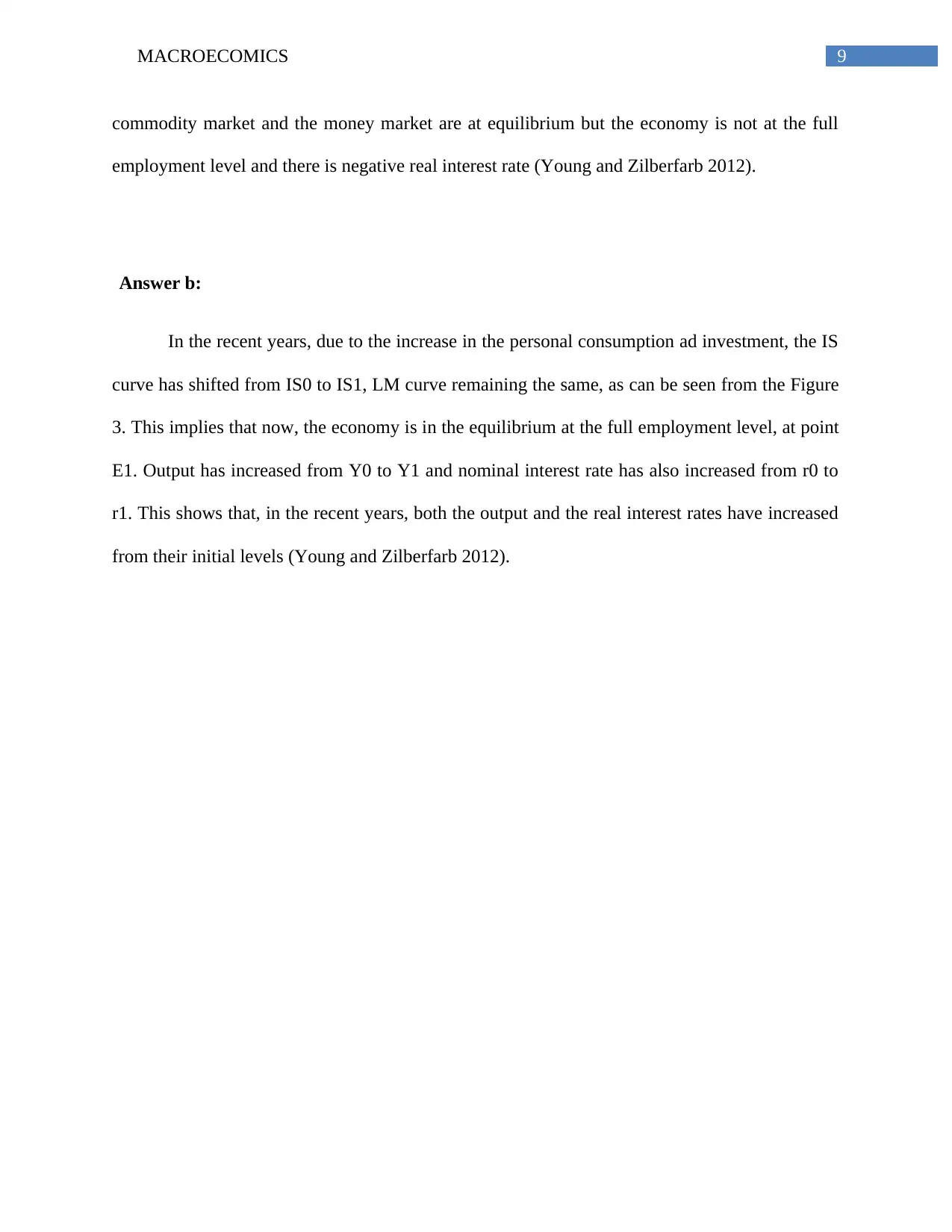
9MACROECOMICS
commodity market and the money market are at equilibrium but the economy is not at the full
employment level and there is negative real interest rate (Young and Zilberfarb 2012).
Answer b:
In the recent years, due to the increase in the personal consumption ad investment, the IS
curve has shifted from IS0 to IS1, LM curve remaining the same, as can be seen from the Figure
3. This implies that now, the economy is in the equilibrium at the full employment level, at point
E1. Output has increased from Y0 to Y1 and nominal interest rate has also increased from r0 to
r1. This shows that, in the recent years, both the output and the real interest rates have increased
from their initial levels (Young and Zilberfarb 2012).
commodity market and the money market are at equilibrium but the economy is not at the full
employment level and there is negative real interest rate (Young and Zilberfarb 2012).
Answer b:
In the recent years, due to the increase in the personal consumption ad investment, the IS
curve has shifted from IS0 to IS1, LM curve remaining the same, as can be seen from the Figure
3. This implies that now, the economy is in the equilibrium at the full employment level, at point
E1. Output has increased from Y0 to Y1 and nominal interest rate has also increased from r0 to
r1. This shows that, in the recent years, both the output and the real interest rates have increased
from their initial levels (Young and Zilberfarb 2012).
Paraphrase This Document
Need a fresh take? Get an instant paraphrase of this document with our AI Paraphraser
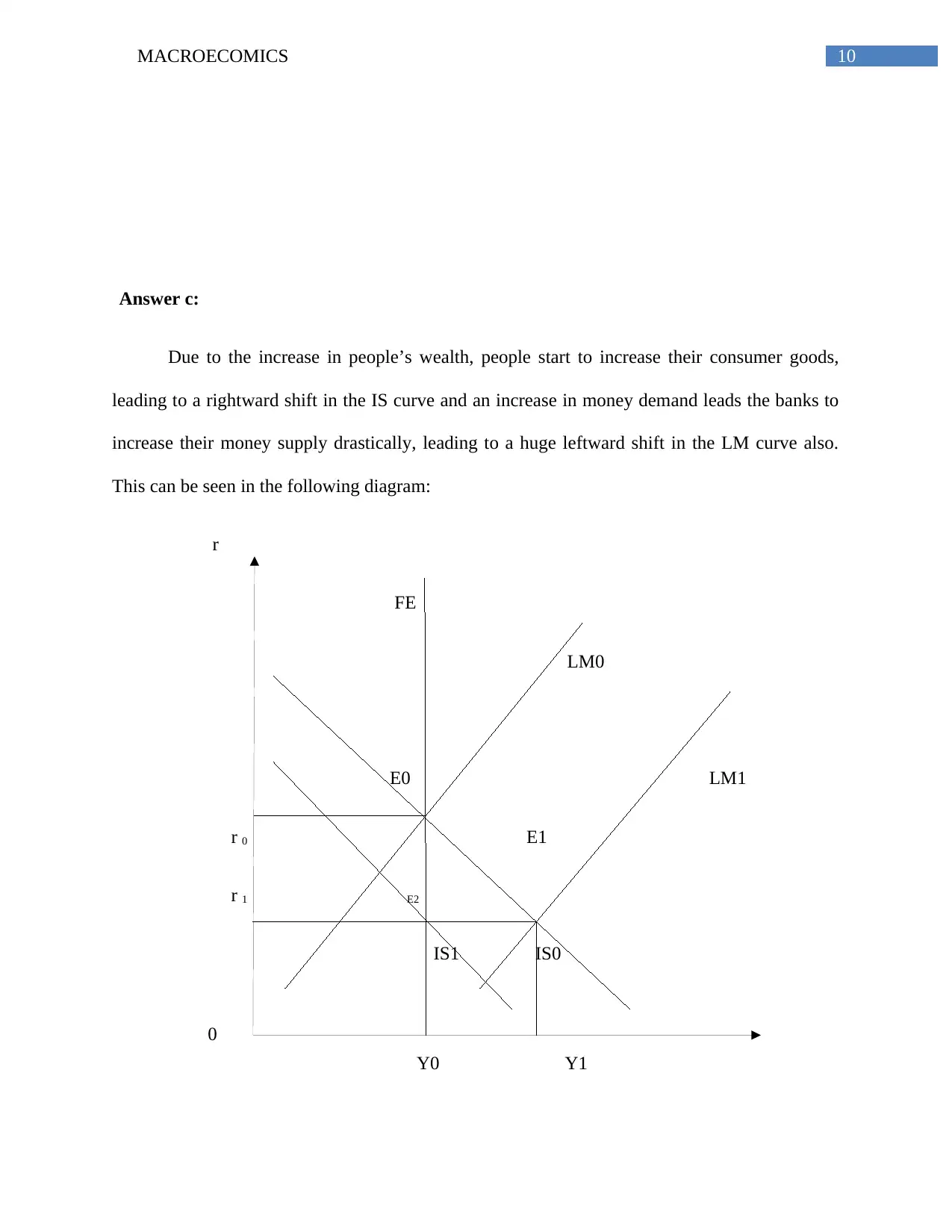
10MACROECOMICS
Answer c:
Due to the increase in people’s wealth, people start to increase their consumer goods,
leading to a rightward shift in the IS curve and an increase in money demand leads the banks to
increase their money supply drastically, leading to a huge leftward shift in the LM curve also.
This can be seen in the following diagram:
r
FE
LM0
E0 LM1
r 0 E1
r 1 E2
IS1 IS0
0
Y0 Y1
Answer c:
Due to the increase in people’s wealth, people start to increase their consumer goods,
leading to a rightward shift in the IS curve and an increase in money demand leads the banks to
increase their money supply drastically, leading to a huge leftward shift in the LM curve also.
This can be seen in the following diagram:
r
FE
LM0
E0 LM1
r 0 E1
r 1 E2
IS1 IS0
0
Y0 Y1
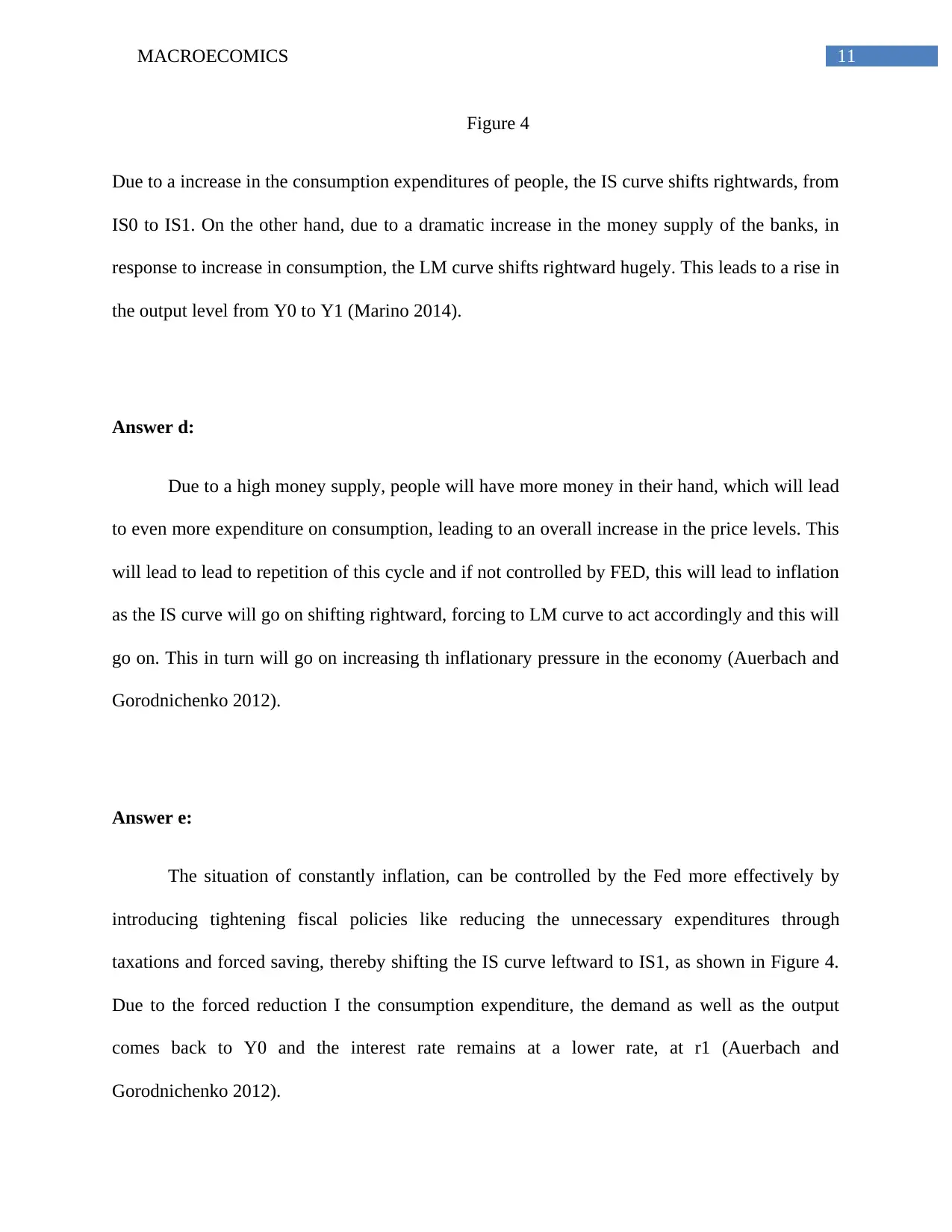
11MACROECOMICS
Figure 4
Due to a increase in the consumption expenditures of people, the IS curve shifts rightwards, from
IS0 to IS1. On the other hand, due to a dramatic increase in the money supply of the banks, in
response to increase in consumption, the LM curve shifts rightward hugely. This leads to a rise in
the output level from Y0 to Y1 (Marino 2014).
Answer d:
Due to a high money supply, people will have more money in their hand, which will lead
to even more expenditure on consumption, leading to an overall increase in the price levels. This
will lead to lead to repetition of this cycle and if not controlled by FED, this will lead to inflation
as the IS curve will go on shifting rightward, forcing to LM curve to act accordingly and this will
go on. This in turn will go on increasing th inflationary pressure in the economy (Auerbach and
Gorodnichenko 2012).
Answer e:
The situation of constantly inflation, can be controlled by the Fed more effectively by
introducing tightening fiscal policies like reducing the unnecessary expenditures through
taxations and forced saving, thereby shifting the IS curve leftward to IS1, as shown in Figure 4.
Due to the forced reduction I the consumption expenditure, the demand as well as the output
comes back to Y0 and the interest rate remains at a lower rate, at r1 (Auerbach and
Gorodnichenko 2012).
Figure 4
Due to a increase in the consumption expenditures of people, the IS curve shifts rightwards, from
IS0 to IS1. On the other hand, due to a dramatic increase in the money supply of the banks, in
response to increase in consumption, the LM curve shifts rightward hugely. This leads to a rise in
the output level from Y0 to Y1 (Marino 2014).
Answer d:
Due to a high money supply, people will have more money in their hand, which will lead
to even more expenditure on consumption, leading to an overall increase in the price levels. This
will lead to lead to repetition of this cycle and if not controlled by FED, this will lead to inflation
as the IS curve will go on shifting rightward, forcing to LM curve to act accordingly and this will
go on. This in turn will go on increasing th inflationary pressure in the economy (Auerbach and
Gorodnichenko 2012).
Answer e:
The situation of constantly inflation, can be controlled by the Fed more effectively by
introducing tightening fiscal policies like reducing the unnecessary expenditures through
taxations and forced saving, thereby shifting the IS curve leftward to IS1, as shown in Figure 4.
Due to the forced reduction I the consumption expenditure, the demand as well as the output
comes back to Y0 and the interest rate remains at a lower rate, at r1 (Auerbach and
Gorodnichenko 2012).
⊘ This is a preview!⊘
Do you want full access?
Subscribe today to unlock all pages.

Trusted by 1+ million students worldwide
1 out of 17
Related Documents
Your All-in-One AI-Powered Toolkit for Academic Success.
+13062052269
info@desklib.com
Available 24*7 on WhatsApp / Email
![[object Object]](/_next/static/media/star-bottom.7253800d.svg)
Unlock your academic potential
Copyright © 2020–2025 A2Z Services. All Rights Reserved. Developed and managed by ZUCOL.




